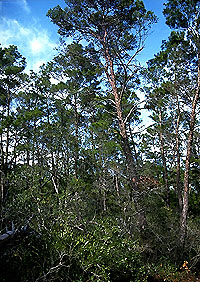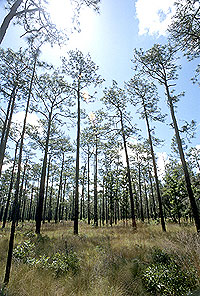|
History Animals & Plants Natural Communities Coastal Dry Uplands Upland Mesic Freshwater Marshes Forested Wetlands Fresh Water Estuaries |
Natural Communities and Habitats:
Dry Uplands: Sandhills and Scrub
Scrub
 Sand pine scrub in Tate's Hell State Forest (Florida Natural Areas Inventory photo) |
A lot of the ground in scrub has nothing growing on it, so it resembles a white sand beach with trees. Stunted-looking oaks, along with saw palmetto, are the dominant plant species in some scrubs; in others, sand pine is the tallest plant. Scrub relies on fire to keep on being scrub. Without fire, other tree species (such as live oak, laurel oak, red oak, sparkleberry, pignut hickory, southern magnolia, and redbay) that can't stand burning will establish themselves, and scrub becomes a xeric hammock -- a different kind of community. With fire, those plants can't get started.
Sand pine is unusual in that the cones in some populations are sealed up with natural resin, and fire is required to open them and release the seeds inside. Fire kills sand pine, so once the parent population has been burned up, a new generation starts up from seed, resulting in a forest of trees all the same age. But other sand pine populations -- including most of those in the Panhandle -- don't have closed cones. Instead, their cones open up and drop their seed in the fall, perpetuating the species and resulting in a forest with trees of many different ages.
It takes a long time to accumulate enough fuel in a scrub forest to sustain a fire. As sand pine grows, its lower limbs die, but they do not fall off the trunk, and once there's enough of them, they'll burn like crazy. In a sand pine forest where the cones are closed until fire opens them, fire releases a lot of seed all at once. In an open-coned population, sand pine can only be regenerated if there are nearby unburned trees to supply seed. If no sand pine seed is available, or if fires are so frequent that sand pine doesn't live long enough to produce seed, then the forest will end up as an oak scrub. (FWC 3, Xeric Oak Scrub, and FWC 4, Sand Pine Scrub)
Typical plants: sand pine, sand live oak, myrtle oak, Chapman's oak, scrub oak, saw palmetto, rosemary, rusty lyonia, ground lichens
Typical animals: oak toad, six-lined racerunner, coachwhip, ground dove, loggerhead shrike, yellow-rumped warbler, rufous-sided towhee
Rare plants: Large-leaved jointweed. telephus spurge, giant orchid
Rare animals: Florida mouse, gopher tortoise, southern hognose snake, Florida pine snake
Where to see it:
Bald Point State Park
Tate's Hell State Forest
T.H. Stone Memorial St. Joseph Peninsula State Park
Sandhill
 This sandhill community has burned often enough to keep turkey oaks small and allow grasses to flourish. (photo courtesy Florida Natural Areas Inventory) |
Before the frenzy of logging and turpentine production in the 19th and 20th centuries, longleaf uplands formed a nearly continuous forest that stretched from Virginia south into the Florida peninsula and west to Texas. An early traveler described the forest that used to go on forever. “There was something, I thought, very graceful in the millions upon millions of tall and slender columns, growing up in solitude, not crowded upon one another…” (B. Hall, 1829, quoted in Myers (1990), p. 153)
What was once longleaf and turkey oak forest is now used for slash pine plantations, farm fields, pastures, and towns and cities. What's left can no longer sustain itself. Sandhills are important aquifer recharge areas, so it's in our interest to take good care of them. Sandhills need fire. Without it, they'll be overwhelmed by shrubs and hardwoods that otherwise would be killed, or at least held in check, by fire. Some sandhill plants won't flower and produce seed if they're not burned, and some species are very choosy about when that fire must happen. A tall, wispy plant called wiregrass is the main fuel producer in sandhills. For many years, botanists thought wiregrass simply never flowered--until a patch was burned in the spring, and lo and behold, it flowered the following fall. Burning in the spring and summer is thought to be best for sandhills because it is when natural, lightning-sparked fires are most likely to start. We can't let natural fires burn any more because they might threaten our safety, our homes, and our businesses, so trained teams conduct carefully planned fires (known as prescribed fires or controlled burns). (FWC 5)
Typical plants: longleaf pine and turkey oak are the dominant trees; grasses and nonwoody plants include wiregrass, pinewoods dropseed, Indian grass, wild buckwheat, queen's delight, yellow foxglove, bracken fern, runner oak, goats rue, partridge pea, milk pea, dollarweeds, wild indigo, gopher apple, and golden-aster; other trees and shrubs include bluejack oak, sand post oak, sparkleberry, persimmon, and winged sumac
Typical animals: barking treefrog, spadefoot toad, fence lizard, mole skink, indigo snake, coachwhip snake, bobwhite, ground dove, red-headed woodpecker, rufous-sided towhee, fox squirrel, pocket gopher
Rare plants: Giant orchid, mock pennyroyal, narrow-leaved phoebanthus, bent golden aster, chaffseed
Rare animals: gopher frog, gopher tortoise, Florida pine snake, eastern diamondback rattlesnake, southern hognose snake, southeastern American kestrel, eastern indigo snake, Florida mouse
Where to see it:
Apalachicola Bluffs and Ravines Preserve (privately owned)
Apalachicola National Forest
Econfina Creek Water Management Area
Edward Ball Wakulla Springs State Park
St. Marks National Wildlife Refuge
Wakulla State Forest
Note: The content of the website has not been updated since 2005. The site remains online for it's value as legacy content and is unlikely to be updated.